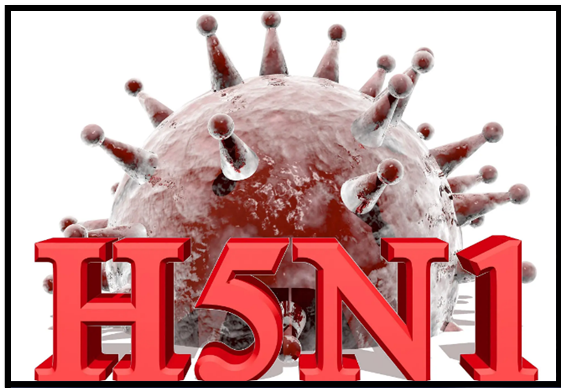THE SPREAD OF AVIAN INFLUENZA
Syllabus:
- GS-2-Health and related aspects
- GS-3- Emerging technology in Health sector
Focus :
- Influenza A H5N1 detected in dairy cows in 6 states in the U.S.
- The exact extent of the spread of H5N1 in cows has not yet been ascertained since cattle are not routinely tested for avian influenza and the symptoms have been relatively mild.
Introduction to Avian Influenza (Bird Flu):
- Avian influenza, commonly known as bird flu, is a highly contagious viral infection primarily affecting birds.
- An emerging new lineage of avian influenza, termed 2.3.4.4b, has been spreading globally since late 2020, carried by migratory birds along specific routes.
- This panzootic has significant effects on avian populations, leading to ecological disturbances and significant economic losses, particularly in the poultry industry.
Spillover to Mammals and Recent Cases:
- In rare instances, the avian influenza virus can infect mammals, leading to spillover events.
- Over the recent years, numerous spillover events have been observed, affecting over 200 species of mammals. The most recent spillover occurred in polar bears in Antarctica.
- Close contact with infected animals increases the risk of spillover to humans, with potentially severe consequences due to the virus’s high fatality rate.
| ABOUT H5N1 :
Contact with diseased birds, their droppings, or infected bird corpses can spread the avian influenza subtype H5N1, which can infect seals, domestic cats, minks, ferrets, and other mammals. Symptoms in Humans : Span the spectrum of mild to severe influenza-like symptoms, including fever, coughing, sore throats, pains in the muscles, nausea, diarrhoea, and vomiting. Seizures, changed mental status, and severe respiratory illnesses (such as pneumonia, viral pneumonia, acute respiratory distress, and difficulty breathing) can also occur in people. |
Multistate Outbreak of H5N1 in Dairy Cows in the U.S.:
- In late March 2024, a multistate outbreak of H5N1 was detected in dairy cows in the United States.
- The outbreak initially manifested as a mystery disease affecting dairy herds in Texas, eventually spreading to Kansas.
- Affected cows displayed symptoms such as loss of appetite, low-grade fever, and reduced lactation, marking the first detection of H5N1 in cattle.
- Concerns arose regarding potential transmission routes and the broader impact on the dairy and meat industry.
Extent of the Outbreak and Challenges in Detection:
- H5N1 has been detected in over 12 herds across six states, including Texas, Kansas, Michigan, New Mexico, Idaho, and Ohio.
- Other animals in proximity to affected farms, such as wild birds and cats, also showed signs of illness and tested positive for the virus.
- The exact extent of the spread within cattle herds remains uncertain due to limited routine testing and relatively mild symptoms.
Human Infection and Public Health Response:
- In April 2024, a human infection of H5N1 was reported in Texas, with the infected individual having contact with infected cows.
- Fortunately, the patient experienced mild illness and recovered after receiving antiviral treatment.
- The Centers for Disease Control and Prevention (CDC) emphasized that the risk of human infections remains low, particularly for individuals with prolonged or close exposure to infected animals.
- This marked the second case of human H5N1 infection reported in the U.S., with sporadic cases reported in several countries since 2003.
Global Concerns and Genetic Insights:
- Globally, concerns about H5N1 rose in Southeast Asia in January 2024 when Cambodia reported two human cases, one resulting in death.
- Researchers sequenced the H5N1 virus from infected cows and the human case, finding both viruses belonging to clade 2.3.4.4b, with a minor mutation potentially linked to adaptation in mammals.
- Despite this mutation, the overall public health risk remains low, according to the CDC.
- Other spillover events involving H5N1 in marine mammals in Peru and deaths of seals in Russia underscore the need for further research to understand the virus’s evolution and potential adaptation to different species.
Conclusion and Recommendations:
- While the current risk of H5N1 transmission to humans is low, disease surveillance and genomic surveillance are crucial for managing the outbreak.
- Continued monitoring of the virus’s genetic makeup and disease surveillance will be essential to track and mitigate potential risks associated with avian influenza outbreaks.
Source:The Hindu
Mains Practice Question :
GS-3
“Discuss the implications of the recent outbreak of H5N1 avian influenza in dairy cows in the United States, highlighting its impact on public health, agriculture, and wildlife”(250 words)




